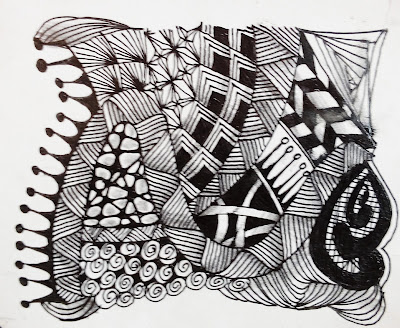Calm Down and Get Your Zentangle On....By - Cathy Malchiodi
Calm Down and Get Your Zentangle On
Zentangle is a self-help art therapy practice to enhance relaxation and focus.
 Zentangle® is known to many artists and craftivistas as a way to create structured designs through drawing various patterns. Sometimes mistakenly called “Zendoodling” or “tangle doodling,” Zentangling or tangling is actually a formalized process that defines itself as something other than mere doodling because of its theory and approach. Rick Roberts and Mary Thomas [www.zentangle.com] are the originators of the trademarked Zentangle method. Basically, it’s a specific way to draw images, most often in black pen on white paper. Zentangle has become an international phenomenon that now has applications in stress reduction, education,therapy and even motivational training.
Zentangle® is known to many artists and craftivistas as a way to create structured designs through drawing various patterns. Sometimes mistakenly called “Zendoodling” or “tangle doodling,” Zentangling or tangling is actually a formalized process that defines itself as something other than mere doodling because of its theory and approach. Rick Roberts and Mary Thomas [www.zentangle.com] are the originators of the trademarked Zentangle method. Basically, it’s a specific way to draw images, most often in black pen on white paper. Zentangle has become an international phenomenon that now has applications in stress reduction, education,therapy and even motivational training.
Zentangle itself may be relatively new, but the basic principles involved are as old as the history of art. It includes ritual [a core practice in ancient and contemporary arts] and mirrors the symbols, designs and patterns of numerous cultures [Mayan, Maori, Celtic, and American Indian, for example] from ancient through present times. And like “doodling” it is based on a human behavior in which one refrains from planning and allows lines and shapes to unintentionally emerge.
There are numerous books on the formal method of Zentangle that will help you get started; these books provide numerous designs and show you how to create various patterns, step-by-step. Or simply search the Internet [especially Pinterest] to find instructions and inspiration for designs—then make up your own once you practice a few patterns. You really only need a few materials to create your designs: a pencil [used to mark out guidelines and to shade areas of designs], a black pen [Micron® pens are recommended, but you can also use the ubiquitous extra fine Sharpie® pen], and heavy white drawing paper or cardstock. The traditional practice of Zentangling uses 3 ½ inch square tiles made of special paper, but you can cut your own choice of paper into squares or completely “break the rules” and tangle on whatever type of paper you want to. If your children want to Zentangle along with you, they will find it easier to draw larger designs with bigger pens such as a fine point Sharpie® or large felt pens.
Why am I interested in Zentangle? While the process may look intricate, it is a deceptively simple pathway to relaxation and inner focus. In fact, proponents of the practice note that it has multiple benefits including calming an anxious mind, increasing self-confidence, and cultivating moment-to-moment awareness in a similar way as mindfulness meditation. Here are some other benefits:It’s Self-Soothing. Repetitive creative work, in and of itself, can be calming and self-soothing. In fact, some of the preliminary research on the Zentangle process indicates that engagement in the process has measurable relaxation benefits. This is particularly true if you accept this process as one with no expected outcome other than the enjoyment of putting the pen to paper and staying open to whatever emerges.
There are numerous books on the formal method of Zentangle that will help you get started; these books provide numerous designs and show you how to create various patterns, step-by-step. Or simply search the Internet [especially Pinterest] to find instructions and inspiration for designs—then make up your own once you practice a few patterns. You really only need a few materials to create your designs: a pencil [used to mark out guidelines and to shade areas of designs], a black pen [Micron® pens are recommended, but you can also use the ubiquitous extra fine Sharpie® pen], and heavy white drawing paper or cardstock. The traditional practice of Zentangling uses 3 ½ inch square tiles made of special paper, but you can cut your own choice of paper into squares or completely “break the rules” and tangle on whatever type of paper you want to. If your children want to Zentangle along with you, they will find it easier to draw larger designs with bigger pens such as a fine point Sharpie® or large felt pens.
Why am I interested in Zentangle? While the process may look intricate, it is a deceptively simple pathway to relaxation and inner focus. In fact, proponents of the practice note that it has multiple benefits including calming an anxious mind, increasing self-confidence, and cultivating moment-to-moment awareness in a similar way as mindfulness meditation. Here are some other benefits:It’s Self-Soothing. Repetitive creative work, in and of itself, can be calming and self-soothing. In fact, some of the preliminary research on the Zentangle process indicates that engagement in the process has measurable relaxation benefits. This is particularly true if you accept this process as one with no expected outcome other than the enjoyment of putting the pen to paper and staying open to whatever emerges.











<3 Brilliant
ReplyDelete